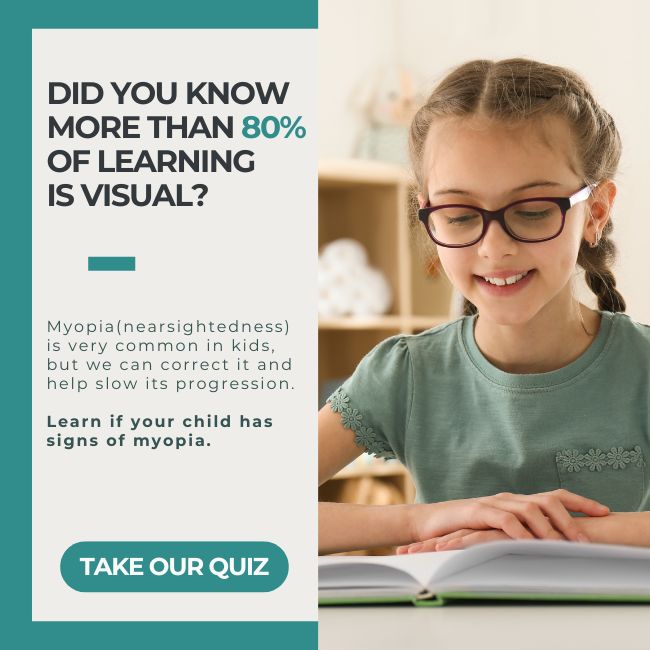Progressive eyeglasses are multifocal lenses designed to help people see clearly at varying distances without the need to switch between multiple pairs of glasses. Progressives provide a gradual transition between prescriptions for near, intermediate, and distance vision. This blend of powers allows wearers to focus on different ranges, like reading a book, working on a computer, or driving, without a visible line between lens segments.
Progressive lenses are often recommended for people with presbyopia, a natural change in vision that typically develops with age and affects the ability to focus on close-up objects. By combining multiple prescriptions into one lens, progressive eyeglasses create a more natural visual experience for day-to-day life.
Progressive Lenses—The Basics
How Progressive Lenses Work
Progressive lenses gradually change their prescription strength from the top to the bottom of the lens. The upper portion is generally used for distance vision, the middle for intermediate tasks like computer work, and the lower area for near activities like reading.
This smooth transition is achieved without the sharp lines found in bifocals or trifocals. Instead, the lens surface shifts gradually, allowing your eyes to adjust naturally when moving between tasks.
Higher-quality progressive lenses, such as free-form designs, are digitally customized to the wearer’s unique measurements. These offer wider and clearer visual zones, especially for intermediate and near tasks, and significantly reduce peripheral distortion compared to standard progressive lenses.
Benefits of Progressive Eyeglasses

One of the main advantages of progressive eyeglasses is convenience. Rather than carrying multiple pairs of glasses for different activities, wearers can rely on a single pair to handle various vision needs. Progressive lenses offer:
- A seamless appearance without visible lens lines
- A natural progression between focal lengths
- Clear vision for multiple activities without needing to switch glasses
Because of their versatility, progressives are a popular choice for people with presbyopia who want a balance between functionality and aesthetics.
Additionally, high-end free-form progressives provide enhanced visual comfort and faster adaptation, making them an excellent option for those seeking premium performance.
Downsides of Progressive Eyeglasses
While progressive lenses provide many benefits, there are some challenges to keep in mind before deciding if they’re the right choice for you.
Adjustment Period
For many people, adapting to progressive lenses takes some time. It may take anywhere from a few days to a few weeks before your vision feels natural. During this adjustment phase, you might notice mild eye strain, dizziness, or a “swim effect” at the edges of the lens. These symptoms usually fade as your eyes and brain learn to work with the new lens design. Consistent, daily wear is the best way to shorten the adaptation process.
The good news is that high-quality free-form progressives greatly reduce these issues. They offer more accurate vision correction and a smoother transition between zones, which helps minimize distortion and shortens the adaptation period.
Higher Cost
Because of their design and precision manufacturing, progressive lenses are often more expensive than single-vision lenses or bifocals. The price can also vary depending on the lens material, coatings, and frame style you choose. For many people, the convenience and natural vision progression are worth the investment. Insurance coverage for progressives differs, so it’s a good idea to check with your vision benefits provider to understand your options.
How to Choose Your Lenses
Not all progressive lenses are the same. Different designs may have varying widths in the reading and intermediate zones, and some are optimized for specific activities like computer work. Lens material, coatings, and frame choice can also affect comfort and performance.
When selecting progressives, factors to consider include:
- Daily activities and vision priorities
- The type of work or hobbies you have
- Lens material and weight
- Frame size and shape for proper lens fitting
Proper measurements are critical for comfort and effectiveness. At Insight Eyecare, we use the Optikam system to take fully personalized measurements. These include:
- Vertex Distance: The distance between the back of the lens and the front of the eye, which affects the effective power of the lens.
- Wrap Angle: The curve of the frame around your face, impacting how light enters the lens.
- Segment Height (Seg Height): The vertical placement of the progressive zone based on your unique eye position in the frame.
- Pupillary Distance (PD): The distance between the centers of your pupils, essential for aligning the lenses correctly.
These customized values ensure optimal lens performance, which cannot be matched by standard or online-ordered progressive lenses.
Adjusting to Progressive Lenses
It’s common for new wearers to experience an adjustment period when switching to progressive lenses. This is because the eyes and brain need time to adapt to the way the prescription changes across the lens.
Some people might notice:
- A narrow field of vision in the intermediate or near zones
- Distortion in peripheral areas
- They need to move their head slightly more to find the clearest view
With consistent use, most wearers adapt within a few days to a few weeks. Practicing daily wear and focusing on different tasks can help speed up this process. Again, choosing high-quality free-form progressives significantly reduces these initial challenges, offering broader, more natural visual zones and a quicker adaptation timeline.
Who Can Benefit from Progressive Eyeglasses?
Progressive lenses are most often recommended for adults over 40 experiencing presbyopia, the age-related change in near vision. They’re particularly helpful for people who find themselves holding books or phones farther away to read, then needing clear vision across the room or while driving.
They’re also a good fit for people who don’t want the hassle of carrying multiple pairs of glasses. Instead of switching between reading glasses, computer glasses, and distance glasses, progressives combine all prescriptions into a single pair. This makes them ideal for professionals who move between tasks at different distances, such as teachers, office workers, and technicians.
Progressive lenses can also appeal to people who value style. With no visible lines like traditional bifocals or trifocals, they offer a more modern, youthful look. For those with active lifestyles, progressives provide consistent vision correction, whether you’re cooking, shopping, travelling, or enjoying outdoor activities, without the interruption of swapping glasses throughout the day.
Where to Get Progressive Eyeglasses
Progressive eyeglasses offer a versatile solution for those who need help seeing at multiple distances. By providing a smooth transition between near, intermediate, and far vision, they make it easier to handle everyday activities without juggling multiple pairs of glasses. While there is an adjustment period, many wearers find they quickly become an essential part of daily life.
It’s important to note that accurate measurements are crucial for successful progressive lens wear. These lenses should be measured and fitted by trained professionals, not purchased online, since incorrect measurements can lead to discomfort, poor vision, and difficulty adapting.
At Insight Eyecare, we use advanced tools like Optikam to capture your individual facial metrics and provide fully personalized lens designs. This ensures the best possible visual experience and helps you get the most from your investment in progressive eyewear. If you’re considering progressives, book an eye exam at Insight Eyecare as your first step. At Insight Eyecare, patients can receive guidance on whether these lenses are a good fit and explore lens designs tailored to their needs and lifestyle.







